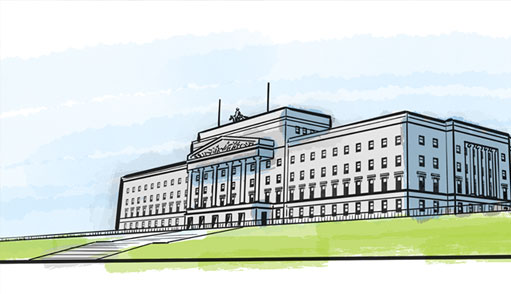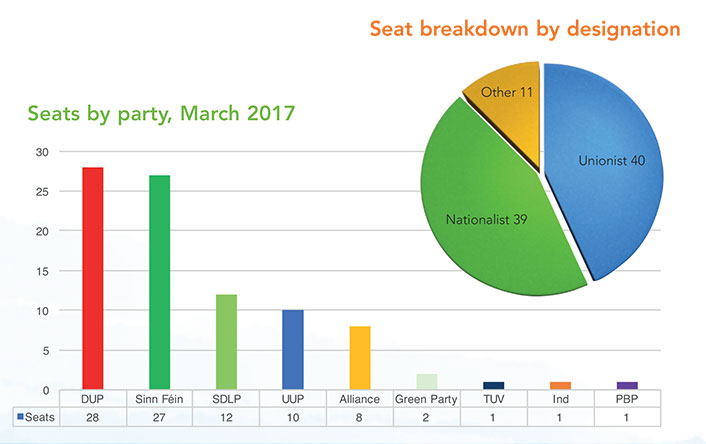Stormont: Unionist majority ended


Significant electoral losses by Northern Ireland’s two main unionists parties will have implications not just for Northern Ireland but for the island as a whole.

Politics at Stormont underwent a watershed moment on 2 March when, for the first time in the history of Northern Ireland, a unionist majority failed to be returned by the electorate. While significant gains were expected to be made by Sinn Féin because of the circumstances surrounding the recent snap election, predictions that they would reduce the previous 10 seat gap between themselves and their former Executive partners, the DUP, to just one seat were not expected.
To offer some context, the state of Northern Ireland was created in 1920 with the aim of securing a permanent Unionist majority. A sectarian headcount was essential to ensure as large a territory as possible, consistent with a secure majority. In fact, the original partition blueprint, which included nine counties, was rejected by James Craig over fears that the Catholic minority would be too large. Until 2017, the dominant unionist majority at Stormont has never been in question but as Ireland approaches the centenary of partition (1921), the mobilisation of the nationalist electorate has, as Sinn Féin leader Gerry Adams put it, provided a “watershed moment”.
The implications are far-reaching and circumstantial as to whether an agreement can be struck to return politics to Stormont but the rise of nationalist support should bear some weight on calls for greater all-island cooperation when tackling the looming implications of Brexit. It has also been suggested that Sinn Féin’s performance will strengthen the party’s potential to enter a governing coalition in the south. The party have proven their ability to align with popular opinion and have also distanced themselves from potential criticism around the operations of government in Northern Ireland by standing outside of it.
A rise in the number of nationalist seats was seen as all the more significant because of the reduction of the number of Stormont seats up for grabs. The election marked the first opportunity to introduce reform which reduced the overall number of MLAs from 108 down to 90.
Overall voter turnout was up by 10 per cent to 64.8 per cent, an initial sign that recent controversy at Stormont appeared to strike a chord with the electorate, interest levels which were last present in 1998.
Despite losing ground to Sinn Féin interms of seats, the DUP were returned as Northern Ireland’s largest party with 28 seats. Sinn Féin increased their vote share by almost 4 per cent, giving them 27 seats, just one short of the DUP. The Alliance Party recorded their highest ever number of votes and achieved 8 seats. Despite entering into what is now viewed as an unsuccessful stance of opposition, the SDLP benefited from greater nationalist voter mobility and transfers from the UUP, ending a steady decline of the party’s votes and achieving 12 seats.
Their opposition party partners however felt the brunt of the unionist vote decline, with their leader Mike Nesbitt announcing his intention to leave the role while vote counting was still under way. They took 10 seats. The Green Party (2), the TUV (1) and Independent Claire Sugden and People Before Profit (1) made up the remainder of allocation.
Added together, those designated as unionists (DUP, UUP, TUV and Claire Sugden) make up just 40 of the 90 possible seats. The DUP’s failure to secure 30 seats, also means that it has lost the ability to wield the Petition of Concern unaided. A valid petition requires the signature of 30 Assembly MLAs and has been used in the past by the DUP to block proposals to lift the ban on same-sex civil marriage in Northern Ireland and changes to abortion laws.
The parties now have three weeks to establish a government. The implications for failure to do so are likely to be a return to direct rule from London. However, the future now hinges on Sinn Féin’s interpretation of their mandate. Their opposition to the DUP leader Arlene Foster’s handling of the RHI green energy scheme came to a head with the resignation of Martin McGuinness, although there have been further issues such as the failure to enact an Irish Language Act and issues of equality and respect within Stormont, which led to the triggering of a snap election. Sinn Féin could read their increased support as backing for their position outside of the Stormont institutions or as an endorsement to go back in stronger than ever before.
Whatever the outcome in the following weeks, the loss of the unionist majority means that Stormont will never be viewed in the same light as it was previously.





